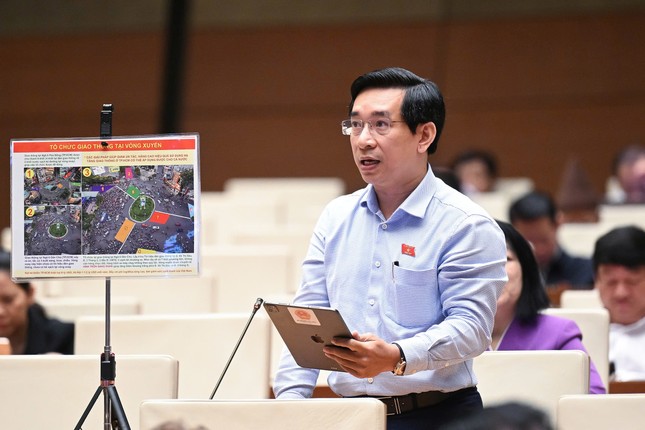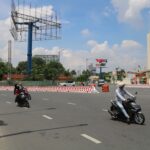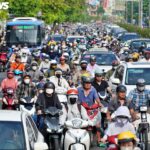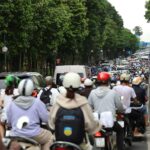Continuing the session, on May 28, the National Assembly discussed the Draft Amended Law on Economical and Efficient Use of Energy.

As usual, delegate Nguyen Van Canh brought vivid illustrative photos to the hall during his speech (Photo: QH)
At the meeting, Delegate Nguyen Van Canh (Binh Dinh) proposed ideas to tackle traffic congestion in major cities.
He argued that if traffic is congested, using any type of fuel will result in energy consumption. He cited statistics showing that Ho Chi Minh City alone loses about $6 billion annually due to traffic jams, while Hanoi loses about $1 billion. This situation increases logistics costs, raises product prices, and diminishes the competitiveness of Vietnamese goods.
Citing the well-organized and efficient traffic management at the Phu Dong roundabout in District 1, Ho Chi Minh City, Mr. Canh suggested that this model could be applied to most congested roundabouts in urban areas nationwide, as traffic at this roundabout is always busy but never jammed, even during peak hours.
Analyzing the situation, the Binh Dinh provincial delegation suggested dividing the hundreds of vehicles into six blocks. The control center can then easily manage these blocks through signal lights to prevent overload and traffic congestion from any direction.
Don’t let enterprises ‘climb the mountain without a rope’
Also at the discussion, delegate Tran Quoc Tuan (Tra Vinh) stated that amending and supplementing the Law on Economical and Efficient Use of Energy is politically significant regarding the commitment to achieve net-zero emissions by 2050.
The delegate mentioned the reality of people using air conditioning despite the cold weather, as long as they are inside a glass building. In Mr. Tuan’s opinion, using energy-efficient insulated glass with proper labeling can save electricity and reduce waste, including the waste of state budget funds.
Additionally, in Europe, America, and Japan, energy labels for building materials have been mandatory for a long time. This practice not only contributes to energy conservation but also enhances the competitiveness of businesses.
However, when implementing this regulation in Vietnam, inevitable challenges will arise, such as the lack of criteria, standards, and a limited number of qualified testing facilities…
Hence, he proposed that when labeling building materials for energy efficiency, the government should issue a mandatory roadmap for certain construction materials with a significant impact on electricity consumption, such as construction glass and insulating materials…
Furthermore, it is necessary to develop Vietnamese standards for energy performance in building materials, aligning with international standards, and socializing testing activities. “We must not let enterprises climb the mountain alone without a rope,” Mr. Tuan emphasized.
The $208 Million Overpass is Open, Yet Traffic Congestion Persists at Ho Chi Minh City’s Northwest Gateway
The newly-opened Tran Quoc Hoan – Cong Hoa route in Ho Chi Minh City has brought some relief to commuters, but the northwestern gateway to the city continues to experience severe congestion.
The New and Improved Expressway: Unveiling the Expanded Pháp Vân – Cầu Giẽ Highway with a Whopping 12 Lanes
The Ministry of Construction has agreed with the proposal by the Vietnam Road Administration and Phuong Thanh Transport Infrastructure Investment and Development Joint Stock Company to research and invest in expanding the Phap Van – Cau Gie expressway to 12 lanes through a public-private partnership (PPP).





















